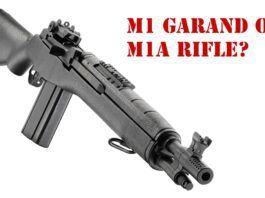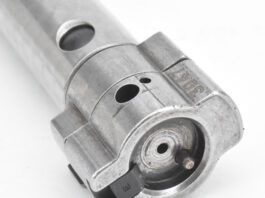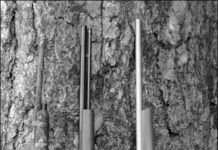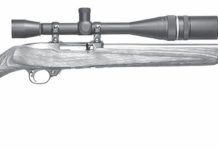New Orleans mayor appeals to legislature
FinalCall.com is reporting that New Orleans Mayor Ray Nagin kicked off a series of closed-door sessions in Baton Rouge to encourage state legislators, in part, to curb access to what he called 'assault weapons.' Banning assault weapons is one of his legislative priorities for sessions that began April 2 and could last until late June. …
CCI Adds Two Segmented Hollow-Point Options
LEWISTON, Idaho – CCI’s Segmented Hollow-Point (SHP) bullet is now available in a 22 Win Mag and a 22 Long Rifle subsonic load.
Tricky Trio of 22 Autoloaders: Marlin Tops Remington, Ruger
The 22 autoloading rifle is an American icon. Many a youngster had one for his first rifle, and while they may not be ideal for that service, they are unquestionably handy rifles for any serious outdoorsman. They can also be excellent training pieces for just about anyone interested in serious shooting.We found three semiautomatic 22 LR rifles at the local gun shop. They were the Marlin Model 60 with tubular magazine and hardwood stock ($179), the Remington 597 SS with stainless barrel and synthetic stock ($283), and a Ruger-made 10/22 Model 1163 LZ distributors special, available through your dealer, with camo stock and laser sight ($526). The tricky laser got our attention. We couldnt resist a good hard look at what it had to offer, other than a scary price tag.Although two of the guns would accept tip-off scope rings and two were drilled for traditional scope bases (the Remington had both), we chose to shoot em with the iron sights provided. One of our reasons was to help us assess the laser sight on the Ruger. Would it prove to be useful in dim light, or against a questionable background where iron sights or even a scope would be hard to use? We intended to find out if that was a useful addition to the rifle, or just another sales gimmick.We tested with three types of ammunition: Winchester Super-X Power Point HP, Aguila Supermaximum Hyper Velocity (yes, thats really the name) solid point (flat nose), and CCI Mini Mag round-nose ammunition. Here is what we found.
Clark 10/17 .17 HMR
This rifle was something of a sleeper. Superficially, it resembled the Briley, but with a shorter barrel and gray-colored laminated stock that had a cheekpiece. Unfortunately, the cheekpiece was of the roll-over type, which the Volquartsen also had, making them less than ideal for left-handers. The Briley alone was ambidextrous. Short of opting for a left-handed stock, the elimination of the roll-over portion of these two stocks would make the rifles easier to use by lefties.When we further assessed some of the Clark’s details, we were impressed.
Wal-Mart Agrees To Gun-Retailing Restrictions
Wal-Mart has agreed to adopt a 10-point retailing system pushed by the anti-gun group Mayors Against Illegal Guns. Wal-Mart, the largest seller of firearms in the nation, cooperated in the drafting of and adopted what the Mayors Against Illegal Guns group calls the Responsible Firearms Retailer Partnership. …
Savage Adds 6 Norma BR, Gets “Shoot House” Bids
Suffield, CT - April 11, 2008 - Savage has announced a new chambering for its precision rifles. For 2008, the following 12 Series Varmint rifles are available in 6 Norma BR: Model 12 Long Range Precision Varminter single shot and repeater models, and the Model 12F Class benchrest model. The Model 12 Long Range Precision Varminters are chambered in 223 Rem, 22-250 Rem, 204 Ruger, and the new round, the 6 Norma BR.
Champion Introduces the EasyHit Fiber Optic Sight
ONALASKA, Wis. – Champion introduces the EasyHit Fiber Optic Sight (MSRP: $21.49). Available spring 2008. In cooperation with world-renown exhibition shooter Tom Knapp, Champion brings this patented training system to shooters looking to increase their score, bag limit or outdoor fun.
Shooters Ridge Expands 10/22 Line to Include Custom Stocks & Target Barrels
ONALASKA, Wis. – Shooters Ridge introduces a new line of 10/22 custom stocks and LR target barrels available in spring 2008.
Heston’s Political Commandment: Thou Shalt Not Abridge Gun Rights
WASHINGTON -- As Moses, Charlton Heston thunderously rallied his people with the Ten Commandments in hand. The tablet of his political life was carved with something else - the Second Amendment.Heston was not just the public face of the gun-rights movement but a good deal of the fire in its belly during a transformational time in the decades-old debate. He lived to see Democrats running away from a cause they once embraced, scared…
Gallup Poll: Public Believes Americans Have Right to Own Guns
The often fierce debate over the Second Amendment has centered on whether it was intended to protect the rights of all Americans to own guns, or only those who are members of state militia groups. The poll makes it clear which side Americans come down on. Gun owners (roughly one-third of the U.S. adult population) are nearly universal in endorsing the view that the Second Amendment guarantees their right to own guns. Non-owners are less likely to view the amendment this way, but a majority still do.
VZ 58 Tactical Sporter and VZ 58 Military Sporter Unveiled
…The Sa vz. 58 was developed by Ing. Jiri Cermak in 1956 and 1957, adopted by the Czechoslovakian army in 1958. and was produced by Ceska Zbrojovka in Uhersky Brod, Czechoslovakia until 1983.
Smith & Wesson Launches Training Program with 3point5.com
Smith & Wesson Corp., announced today that it has entered into an agreement with the online training company 3point5.com to provide retail sales training support for the Company’s Smith & Wesson, Walther and Thompson/Center Arms products.
































